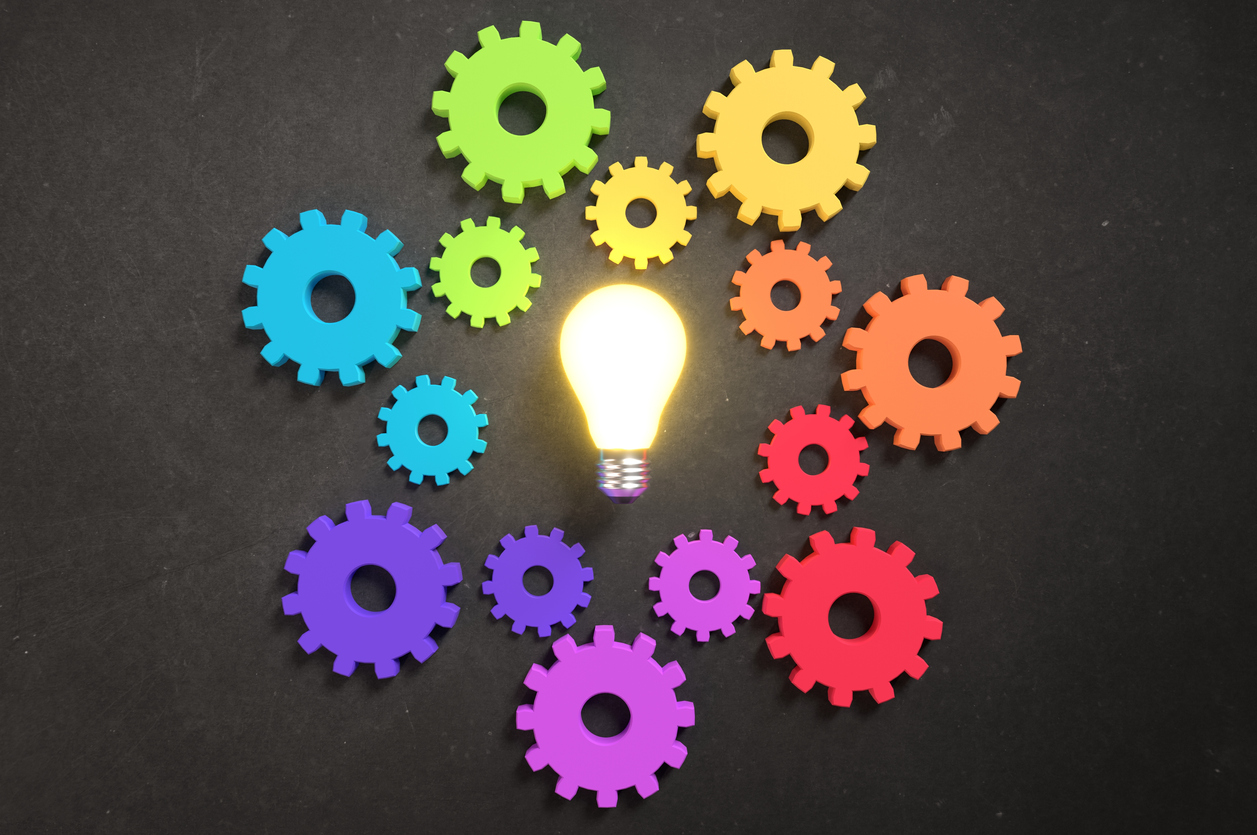It is well documented that in this age of widespread disruption, companies must innovate continuously, creating new markets, experiences, products, services, content or processes. So how can leaders encourage innovation? It’s more than recruiting the brightest minds. While having the best talent is clearly an asset, people need the right culture to flourish.
We have found that a culture of equality—the same kind of workplace environment that helps everyone advance to higher positions—is a powerful multiplier of innovation and growth. This means that building a culture of equality is not just an ethical imperative, it is also a business priority. Put simply, if organizations want to thrive, they have to ‘get to equal’.
The power of a workplace culture of equality to drive employees' innovation mindset—their willingness and ability to innovate—is strong. In our research it had It had more impact than age or gender and lead to an increase in innovation mindset in all industries and all countries. In fact, we found that the innovation mindset is six times higher in the most-equal cultures than in the least-equal ones.
Innovation also equals economic potential. Among the more than 18,000 employees in 27 countries surveyed, we found that people are more willing and able to innovate in faster-growing economies and in geographies with higher labour-productivity growth. And the stakes are enormous: we calculate that global gross domestic product would increase by up to US$ 8 trillion by 2028 if the innovation mindset in all countries was raised by 10 per cent.
Ellyn J. Shook is Chief Leadership & Human Resources Officer, Accenture. Julie Sweet is Chief Executive Officer – North America, Accenture. Their complete report, “Equality=Innovation: Creating a Culture That Drives Innovation” is available online.
This article is republished here with permission from `Rotman Management`, the magazine of the University of Toronto's Rotman School of Management
No matter who or where they are, if people feel a sense of belonging and are valued by their employer for their unique contributions, perspectives and circumstances, they will be empowered to innovate more.
Innovation mindset is a new way to measure an individual’s ability and willingness to innovate. It is enabled by six key elements which are based on extensive sources, including academic and business research and Accenture-owned diagnostic tools and thought leadership. The six elements of an innovation mindset are:
Purpose: Alignment around and support for the purpose of the organization.
Resources: Having the tools, time and incentives necessary to innovate.
Collaboration: Working with other departments or in fluid, crossfunction teams.
Autonomy: Being shown a clear mandate for change—and being trusted to follow through.
Inspiration: Tapping into inspiration from beyond the organization.
Experimentation: Experimenting with new ideas quickly without fear of failure.
We surveyed employees about their experience with these six elements in the workplace, asking them about the extent to which ‘I am encouraged to look for inspiration outside my organization’ (Inspiration) or ‘The purpose of the organization makes me proud to work here’ (Purpose). The more strongly a person agreed that these elements applied, the higher their innovation mindset score.
Using an econometric model, we were then able to show how an innovation mindset would change if people worked in a more-equal culture. Our finding: As a culture improves with respect to equality, the innovation mindset improves. Indeed, we found that for every 10 per cent improvement in culture factors, innovation mindset increased by 10.6 per cent. These improvements are underpinned by three pillars of a culture of equality: bold leadership, an empowering environment and comprehensive action. We will describe each in turn.
Pillar 1: Bold leadership
Culture starts at the top. Setting and publishing diversity targets, holding the leadership team accountable and measuring progress are critical steps. Leaders must give employees the resources they need to innovate and the freedom to fail. Here are four ways to achieve this.
Prioritize diversity and equality. Establish diversity, equal pay and advancement goals.
Encourage risk-taking. Ensure that employees know they have the freedom to experiment and help them learn from their failures.
Set up to innovate. Design-in the necessary time, space, resource and technologies needed to innovate and continually encourage and reward innovation.
Make leaders accountable. Track progress, make leaders accountable.
Pillar 2: Empowering environment
Training, greater flexibility and commitment to work-life balance are the most powerful drivers of an innovation mindset. This area is where there is the greatest opportunity for impact, as it accounts for 70 per cent of innovation mindset gains. Employees are empowered by a shared sense of purpose, paired with autonomy, which helps them reach their individual potential. Here are five characteristics of an empowering environment.
Be clear on purpose. Ensure that employees know the purpose of the organization and how their work aligns with it.
Fiercely promote flexible working. Have the leadership team set a positive example around work-life balance. Use technology to enable people to have more say over where, when and how they work.
Train effectively. Offer employees engaging and flexible training programs so they can acquire skills for the future.
Let people be themselves. Don’t ask them to conform when it comes to appearance; encourage inclusion in every way.
Pillar 3: Comprehensive action
Forward-looking policies and practices are important, but they must also be evenly accessible to all, to ensure that individuals or groups don’t feel singled out or held back. When employees are inspired by those inside and outside the organization, their commitment to living the company’s core values, and for collaborating with one another, grows. Here are four ways to achieve this.
Send a loud and broad signal. For example, encourage all new parents—not just birth mothers—to take leave.
Cross-train and rearrange teams. Use work rotations, temporary assignments or horizontal career moves to give people opportunities to grow skills and to share knowledge across the organization.
Use networks. Encourage collaboration and support through networks for your employees.
Look outward. Bring the outside in. Encourage people to develop external networks and partnerships and to attend events where they meet others and hear new ideas.
Leading the way: The exemplars
One example of a company committed to—and benefiting from—a culture of equality is Mastercard. Its stock soared over 35 per cent last year, and the company is growing rapidly as it ushers in a cashless society. “Diversity is built into the core of what we do,” says President and CEO Ajay Banga. Indeed, the company boasts twice the number of women in leadership as other companies in the S&P 500.
“We’re in an industry where technology and innovation flow around you all the time. If you surround yourself with people who look like you, walk like you, talk like you, went to the same schools as you and had the same experiences, you’ll have the very same blind spots as them. You’ll miss the same trends, curves in the road and opportunities.”
Banga cultivates a bright, diverse workforce, but he’s also looking for something he calls ‘a high D.Q.’—decency quotient. For him, decency is about being there for employees and engendering trust among them. Trust, he says, breeds innovation: “If you want things to happen, everyone has got to be open and trusting.”
The CEO stresses that a company-wide effort and shared sense of purpose have helped Mastercard thrive as a more-equal culture and as a corporation. The company is currently innovating in the area of financial inclusion, helping to provide access and tools to two billion people in the world without a bank account. “We’ve reached 380 million people as of now. I think we have a line of sight to 500 million,” Banga says. “The idea is to make it happen everywhere, from Africa to Brazil to Eastern Europe.”
It’s a business priority that is perfectly aligned with, and driven by, Mastercard’s culture of equality. When the right tone is set from the top and everyone in an organization is empowered, trusted and armed with a mission, together they can unlock unprecedented opportunity.
Banga’s leadership philosophy is validated by new Accenture research: When employees work in more-equal cultures, they are much more likely to have an innovation mindset. In fact, an innovation mindset is six times higher in the most-equal cultures vs. the least-equal ones.
Even companies that have some, but not most, of the culture-of-equality factors can gain a great deal from being more like the best: An innovation mindset is twice as high in the most-equal companies than in typical ones. It’s a powerful incentive for these organizations to take the leap from ‘ok’ to ‘truly equal’.
What else do employees in most-equal cultures have in common with one another? For one thing, they see fewer barriers to innovating at work. And they’re also less afraid to fail.
Culture’s power to unleash innovation is blind to industry, country and various workforce demographics. Among those surveyed, people across all genders, sexual identities, ages and ethnicities show a stronger innovation mindset in more-equal workplace cultures. Against every factor we tested, culture wins.
Diversity is a building block: Equality is a multiplier
Organizations know that fostering diversity—the extent to which members of a company’s workforce, including the leadership team, differ from each other in terms of age, ability, ethnicity, gender, gender identity or expression, religion or sexual orientation—is important. Diversity remains a critical building block to unleashing innovation.
However, a culture of equality is an essential multiplier to help maximize innovation. While the impact of diversity factors alone on innovation mindset is significant, it is much higher when combined with a culture of equality. In the most-equal and diverse cultures, innovation mindset is 11 times greater than in the least-equal and diverse cultures. In a culture of equality, people are truly valued for their differences and free to be who they are. They’re not just there to check a box—they’re empowered to contribute.
One of Procter & Gamble’s priorities is creating a culture that empowers all employees to ‘perform at their peak’. To achieve this, P&G leadership has rolled out programs dedicated to achieving equal representation of women at every level and arming employees with the skills and experiences they need to bring disruptive ideas to the table. These include their Women’s Accelerator Program and Athena in Action—initiatives that engage high potential women at critical career points to prepare them for senior roles.
Additionally, the company’s Intentionally Inclusive Leadership Training program teaches employees how to identify and overcome bias. As one of the world’s largest advertisers, P&G also leverages its voice in advertising and media to tackle bias, spark conversations and promote equality through campaigns such as Always #LikeAGirl, Ariel #ShareTheLoad and Gillette’s We Believe.
Marriott International is another company that takes equality seriously. Its deep commitment to the professional development of its diverse employee population has allowed it to put innovation at the centre of its growth strategy. It has launched Voyage Global Leadership Development—an award-winning program offering resources and support for future company leaders across Marriott’s hotel brands. Additionally, the company’s Emerging Leaders program has rapidly accelerated the advancement of women and minorities to senior leadership positions. Marriott continues to reshape travel and leisure and attract the next generation of travelers by launching new brands, creating tech-centric guest experiences and fostering unique partnerships, including one with Alibaba in China.
Elsewhere, over the past five years, Microsoft has set about reinventing itself and is once again one of the most valuable companies in the world today. This re-emergence has manifested in different ways, including a strategic shift toward cloud computing. But this resurgence would not be occurring if it weren’t for the strength of its evolving culture, which underpins everything the company is doing today. This culture evolution is grounded in the fundamental belief that inclusion throughout the organization, from executives and managers to employees around the world, is table stakes for innovation. It means that every employee be their best self at work and apply a growth mindset to help Microsoft be more responsive to the needs of both customers and employees.
This can be seen in everything from the company’s ‘core priority’ on inclusion for all employees; to posters and signage that encourage people to invite in new ideas and foster creativity; to Microsoft’s ‘Outside In’ program, in which luminaries and thought leaders from all walks of life are invited to the company’s Redmond campus to meet with employees; to a monthly all-company Q&A with CEO Satya Nadella and his leadership team.
Employees are encouraged to take an active role—working with their managers—to chart the career path that is right for them, and managers in turn are given tools and training that help them be better leaders for their teams. This evolving culture can perhaps best be seen during Microsoft’s One Week event, when employees from around the world come together each July for a week of collaboration, partnership and learning opportunities. The event is highlighted by a three-day Hackathon where thousands of employees work on small teams creating new technology solutions and products—many of which are designed for social good.
Microsoft’s shift from a ‘know it all’ culture to a ‘learn it all’ culture has invited an entirely new world of potential for the company, producing game-changing innovations and a more empathetic workplace. From its augmented reality HoloLens to artificial intelligence for the visually impaired, Microsoft is making the world a better place. But it started with making Microsoft a better company first.
In closing
Are you ready to build a culture of equality where people can thrive and create? As a starting point, you should have an inclusion and diversity (I&D) strategy in place—one that is aligned with your overall business plan. This strategy will form a critical foundation on which leaders can take action and drive progress. Then it’s time to embrace the three pillars of a culture of equality. As indicated herein, by fostering bold leadership, an empowering environment and comprehensive action, your organization will be primed to be more innovative than ever before.



